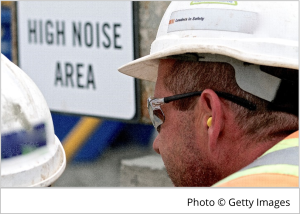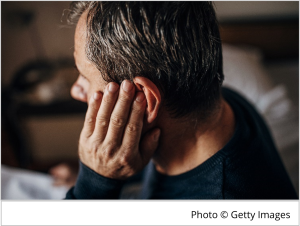Save Your Hearing Day
Posted on byThe blog content comes from the NIOSH Manufacturing Mondays seminar series.
Today is National Save Your Hearing Day. Hearing loss is one of the most common work-related illnesses. [1]
- About 12% of U.S. workers have hearing difficulty. [2]
- Among noise-exposed workers, 23% have hearing difficulty compared to 7% of non-noise-exposed workers. [3]
- Twenty-four percent of worker hearing difficulty is due to occupational exposures including hazardous noise and ototoxic chemicals (chemicals causing damage to the auditory system). [4]
- Approximately 22 million workers (14%) are exposed to hazardous noise each year.[2]
- About 10 million are exposed to solvents (ototoxic) [5], and an unknown number are exposed to other ototoxicants.
 Noise exposure is the primary cause of most occupational hearing loss. Machinery, hand-held equipment, crowds, music, megaphones, gunfire, alarms, and the combination of multiple noise sources in the same area, all contribute to the noise level, and thus increase the risk of hearing loss. While there are noise-exposed workers in every industry, some industries have higher risks for hearing loss, including the manufacturing sector. Forty-six percent of manufacturing workers have a history of occupational noise exposure. [2] However, 28% of noise-exposed workers in manufacturing report not wearing their hearing protection while working in noise. [6]
Noise exposure is the primary cause of most occupational hearing loss. Machinery, hand-held equipment, crowds, music, megaphones, gunfire, alarms, and the combination of multiple noise sources in the same area, all contribute to the noise level, and thus increase the risk of hearing loss. While there are noise-exposed workers in every industry, some industries have higher risks for hearing loss, including the manufacturing sector. Forty-six percent of manufacturing workers have a history of occupational noise exposure. [2] However, 28% of noise-exposed workers in manufacturing report not wearing their hearing protection while working in noise. [6]
This has led to workers losing their hearing. Twenty percent of noise-exposed manufacturing workers have a material hearing impairment, meaning their hearing loss is severe enough that they have difficulty understanding speech. Sub-sectors within manufacturing have even higher percentages of workers with impairment, including petroleum and coal products (26%), primary metal (25%), and machinery (25%). [7]
 Hearing loss can have a profound impact on quality of life. It is associated with cognitive decline [8] and cardiovascular outcomes such as hypertension and coronary heart disease. [1] It is also strongly associated with depression. [8, 9] Tinnitus, which often co-occurs with hearing loss, can disrupt sleep and concentration and is associated with both depression and anxiety. [10] While the total cost of worker hearing loss is unknown, annual workers compensation claims for hearing loss alone cost at least tens of millions of dollars. [11] Costs for workers with hearing loss include paying for hearing aids and clinical rehabilitation (e.g., fitting hearing aids, learning compensation strategies to optimize hearing). [12] Workers who cannot effectively communicate are less likely to be promoted and their careers suffer [1]. Workers with profound hearing loss may leave the workforce entirely. Workers with hearing loss are also at higher risk for costly occupational injuries.[13]
Hearing loss can have a profound impact on quality of life. It is associated with cognitive decline [8] and cardiovascular outcomes such as hypertension and coronary heart disease. [1] It is also strongly associated with depression. [8, 9] Tinnitus, which often co-occurs with hearing loss, can disrupt sleep and concentration and is associated with both depression and anxiety. [10] While the total cost of worker hearing loss is unknown, annual workers compensation claims for hearing loss alone cost at least tens of millions of dollars. [11] Costs for workers with hearing loss include paying for hearing aids and clinical rehabilitation (e.g., fitting hearing aids, learning compensation strategies to optimize hearing). [12] Workers who cannot effectively communicate are less likely to be promoted and their careers suffer [1]. Workers with profound hearing loss may leave the workforce entirely. Workers with hearing loss are also at higher risk for costly occupational injuries.[13]
Prevention
Occupational hearing loss is permanent, but it is 100% preventable. Exposures at or above the NIOSH Recommended Exposure Limit (REL) for occupational noise exposure are considered hazardous. The NIOSH REL for occupational noise exposure is 85 decibels, A-weighted, as an 8-hour time-weighted average (85 dBA as an 8-hr TWA) using a 3-dB exchange rate.
Employers should use the NIOSH Hierarchy of Controls to reduce workplace noise to below the NIOSH REL whenever possible. The Hierarchy of Controls prioritizes eliminating the noise, buying quiet equipment and tools, controlling the noise hazard, and exposure time limits. When hazardous noise levels cannot be adequately reduced hearing protection should be used.
Exposure to chemicals that may damage hearing should also be reduced or eliminated by but using a less-toxic or non-toxic chemical, wearing gloves, long sleeves and eye protection, wearing a respirator or other protective equipment as appropriate, and reading and following all chemical safety instructions.
NIOSH is involved in a range of occupational safety and health activities including research, surveillance, and research to practice. The Hearing Loss Prevention Research Program conducts research in key priorities for promoting the prevention of occupational hearing loss. The Occupational Hearing Loss (OHL) Surveillance Program serves as a national surveillance system for this common condition. The NORA Hearing Loss Prevention Cross-Sector Council brings together individuals and organizations to share information, form partnerships, and promote adoption and dissemination of solutions that work.
NIOSH continues to provide national and world leadership to reduce the prevalence of occupational hearing loss. See the blog NIOSH Noise: A 50-Year Timeline of Research and Intervention for more information on NIOSH noise research. For more information on Hearing Loss Prevention Cross Sector Research and how you can get involved, please email Elizabeth Masterson at emasterson@cdc.gov and/or Amanda Azman at aazman@cdc.gov.
Additional links and resources:
- Hearing Loss Prevention Program Performance One-Pager(PPOP)
- Hearing Loss Prevention Cross-Sector Council Research Agenda
- NORA Hearing Loss Prevention Cross-Sector Council
- NIOSH Science Blogs – Hearing Loss category
- Safe-in-Sound Excellence in Hearing Loss Prevention Award
- NIOSH Sound Level Meter App
- NIOSH Buy Quiet Initiative
Elizabeth A. Masterson, PhD, CPH, COHC, is a Co-Coordinator for the NIOSH Hearing Loss Prevention Cross-Sector Program.
Thais C. Morata, PhD, is a Co-Coordinator for the NIOSH Hearing Loss Prevention Cross-Sector Program.
Amanda Azman, Au.D, is a Research Audiologist in the NIOSH Pittsburgh Mining Research Division.
RJ Matetic, MS, PhD, NIOSH Associate Director for Manufacturing.
Adam Smith, PhD, NIOSH Manufacturing Sector Program Assistant Coordinator.
Gary Roth, MS, PhD, NIOSH Manufacturing Sector Program Co-Coordinator.
Jenny Topmiller, MS, NIOSH Manufacturing Sector Program Co-Coordinator.
Richard Current, PE, NIOSH Manufacturing Sector Program Assistant Coordinator.
The blog content comes from the NIOSH Manufacturing Mondays seminar series. The Manufacturing Program uses Mondays to highlight happenings within the program and throughout the world of Manufacturing. Some weeks feature seminars by internal or external speakers while others will share recent news and interesting facts related to the Manufacturing community. Many of these topics will also be highlighted here on the NIOSH Science Blog. To share your ideas for future topics or to sign up to receive the Manufacturing Monday emails contact us at mnf-program@cdc.gov.
References
- Themann C, Suter A, Stephenson M [2013]. National Research Agenda for the Prevention of Occupational Hearing Loss—Part 1. Semin Hear 2013 34(03): 145-207. DOI: 10.1055/s-0033-1349351
- Kerns E, Masterson E, Themann C, Calvert G [2018]. Cardiovascular conditions, hearing difficulty, and occupational noise exposure within US industries and occupations. Am J Ind Med.61 (6): 477-491. https://doi.org/10.1002/ajim.22833
- Masterson E, Themann C, Luckhaupt S, Li J, Calvert G [2016a]. Hearing difficulty and tinnitus among U.S. workers and non-workers in 2007. Am J Ind Med. 59 (4): 290-300. https://doi.org/10.1002/ajim.22565
- Tak S, Calvert G [2008]. Hearing Difficulty Attributable to Employment by Industry and Occupation: An Analysis of the National Health Interview Survey—United States, 1997 to 2003. J Occup Environ Med. 50 (1): 46-56. doi: 10.1097/JOM.0b013e3181579316
- NIOSH [1987]. Current Intelligence Bulletin 48 Organic Solvent Neurotoxicity. Cincinnati, OH:US DHHS, CDC, NIOSH, DHHS (NIOSH) publication No. 87-104, https://www.cdc.gov/niosh/docs/87-104/default.html.
- Green D, Masterson E, Themann, C [2021]. Prevalence of hearing protection device non-use among noise-exposed US workers in 2007 and 2014. Am J Ind Med. 64 (12): 1002-1017. https://doi.org/10.1002/ajim.23291
- Masterson E, et al. [2013]. Prevalence of hearing loss in the United States by industry. Am J Ind Med. 56(6): 670-681. https://doi.org/10.1002/ajim.22082
- Chien W, Lin F [2012]. Prevalence of Hearing Aid Use Among Older Adults in the United States. Arch Intern Med. 172(3): 292–293. doi: 10.1001/archinternmed.2011.1408.
- Hetu R, Getty L, Quoc HT [1995]. Impact of occupational hearing loss on the lives of workers. Occup Med. 10(3):495-512.
- Shargorodsky J, Curhan G, Farwell W [2010]. Prevalence and Characteristics of Tinnitus among US Adults. Am J Med. 123 (8):711-718. https://doi.org/10.1016/j.amjmed.2010.02.015
- Themann C, Masterson E [2019]. Occupational noise exposure: A review of its effects, epidemiology, and impact with recommendations for reducing its burden. J Acoust Soc Am 146 (5). https://doi.org/10.1121/1.5134465
- Masterson E, Bushnell T, Themann C, Morata T [2016]. Hearing Impairment Among Noise-Exposed Workers — United States, 2003–2012. MMWR Morb Mortal Wkly Rep. 65(15);389–394. http://dx.doi.org/10.15585/mmwr.mm6515a2
- Girard SA, et al., [2015]. Occupational noise exposure and noise-induced hearing loss are associated with work-related injuries leading to admission to hospital. Injury Prev. 21 (e1). http://dx.doi.org/10.1136/injuryprev-2013-040828
Posted on by

